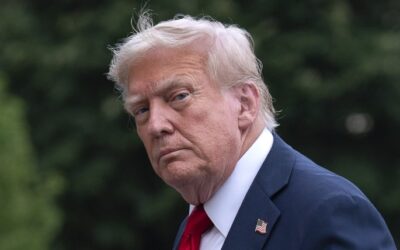A wild week for the Trump economy

Tariffs putting the squeeze on businesses and consumers while bringing in billions of dollars for the United States government. A job market that is showing major signs of cracking even as the unemployment rate remains subdued. Tech stocks surging on Wall Street, fueled by the artificial intelligence boom — as many other sectors are ailing.
As Commerce Secretary Howard Lutnick said on social media earlier this week: “the Trump economy has officially arrived.”
The past week was already primed to be a doozy for data, with investors and analysts eagerly anticipating updates about economic growth, jobs and the Fed’s latest interest rate decision. Major companies like Apple, Amazon, Meta and Microsoft reported their latest financial results. Trump’s deadline for trade deals was set for Friday.
But what happened this week turned out to be more extraordinary than anyone expected.
“I’m sending off red flares: We’re on the precipice of a recession,” said Mark Zandi, chief economist at Moody’s Analytics, a financial research company. “If tariffs keep increasing, I don’t know how we avoid a recession.”
Coming into this week, the U.S. economy had generally been considered in good shape despite mounting uncertainty and concerns about slowing growth.
The week kicked off in Scotland with the announcement of a deal with the European Union that would set tariffs at 15%, ending months of uncertainty surrounding the United States’ largest trade partner.
Trade talks then moved to Sweden, where leading officials from the U.S. and China held two days of negotiations. The talks yielded neither a deal nor a formal extension of the two countries’ trade truce, which will expire Aug. 12.

“The meetings were very constructive,” Treasury Secretary Scott Bessent told reporters after the talks wrapped up. “It’s just that we haven’t given the sign-off.”
Given the importance of trade relations between the world’s two largest economies, the cliffhanger meant the cloud of uncertainty created by Trump’s tariffs gambit persisted, despite some deals having been struck with other major trading partners including the European Union and Japan.
Tuesday offered little reason for renewed optimism, with the international shipping giant UPS again declining to issue financial forecasts for the rest of the year, prompting investor concern about the impact of Trump’s shifting trade war and causing company shares to tank.
Wednesday began with the Commerce Department reporting figures for second-quarter gross domestic product, or GDP, which measures economic growth in the U.S. The data showed an annual gain of 3%, beating expectations. But the same report also contained worrisome signs about business investment, even as price growth was accelerating.
Later that day, the Federal Reserve announced it was keeping its benchmark interest rate unchanged, in part due to those inflation concerns. That drew the ire of Trump, who has spent weeks hounding Fed Chair Jerome Powell to lower the key lending rate. In remarks following the central bank’s announcement, Powell pointed to ongoing concerns about the potential for Trump’s tariffs to raise prices for U.S. consumers — but critically, referred to the jobs market as “solid.” Notably, two members of the rate-setting board — both appointed by Trump — dissented, the first time that has occurred in more than three decades.
Blowout earnings from Microsoft and Facebook parent Meta — two companies at the center of the AI investment boom, which is a key part of Trump’s domestic agenda — helped the stock market reach fresh highs early Thursday. Microsoft briefly became the second company to be worth more than $4 trillion on the stock market.
Yet by the time the markets closed that day, stocks had erased their gains after Trump sent letters to more than a dozen pharmaceutical companies demanding they offer U.S. customers more competitive pricing for new medicines and giving them 60 days to comply.
Late Thursday evening, Trump unveiled a sweeping new set of tariffs that unilaterally imposed higher import taxes on a host of trading partners, including allies like Canada and Taiwan. The new effective rate of more than 15% delivered a shock to global markets. The month closed with the Treasury Department reporting monthly tariff collections had hit another new record of more than $29 billion.
In an interview with NBC News that evening, Trump touted the expansive new tariffs, saying he believed it all was going “very well, very smooth,” even as he remained open to new deals.
Then Friday’s jobs report arrived.
At 8:30 a.m., the Bureau of Labor Statistics published revisions showing sharply lower jobs totals for May and June than initially reported, while also finding the economy had added just 73,000 jobs in July, far below expectations. All told, it suggested the U.S. has gained an average of just 35,000 jobs a month over the past three months — and excluding the increases seen in the health care industry, the U.S. had lost more jobs than it had created.
The unemployment rate, however, remained at 4.2%, a sign that overall joblessness remains subdued. However, many economists noted the data point is largely attributable to the president’s immigration crackdown, which is shrinking the overall labor force.
The White House hailed the loss of foreign-born workers as it also noted a more sustained increase in the labor force among native-born workers.
“If we’re swapping out foreign-born job holders for American-born job holders, I think that’s a win,” White House chief economic adviser Stephen Miran told Axios.
He added that there was “really good reason” to believe the economy would improve, citing Trump’s trade deals and tax cuts.
But for Trump, the public’s larger takeaway of a weakening labor market prompted an unprecedented response: Shortly after 2 p.m. ET on Friday, the president announced his intention to fire the head of the Bureau of Labor Statistics over what he said were errors in the jobs data, as well as accusations the agency had “manipulated” the numbers prior to the 2024 election. Neither allegation has been corroborated.
The move sent shockwaves through Washington, with some experts warning it risked lowering the U.S. to the level of authoritarian regimes.
“President Trump is once again destroying the credibility of our government by firing expert and nonpartisan officials because he does not like the facts that they present,” said Max Stier, the CEO of the nonpartisan Partnership for Public Service. “Governments that go down this path find themselves in ugly territory very quickly.”
It was not clear whether the outgoing BLS commissioner, Erika McEntarfer, a Biden administration appointee, would seek to challenge her removal in court. As it turns out, in addition to nominating a new head of the critical data agency, Trump will also get to name a new member to the Fed’s rate-setting board after Adriana Kugler, another Joe Biden appointee, unexpectedly announced her resignation late Friday. Both nominees still must be confirmed by the Senate, which remains narrowly controlled by the GOP.
Asked if the White House continued to harbor concerns about the direction of the economy, Kush Desai, a White House spokesman, issued the following statement:
“In his first term, President Trump used an America First economic agenda to deliver historic working class prosperity and the first reduction in wealth and income inequality in decades. In his [second] term, President Trump is implementing the very same policy mix of deregulation, fairer trade, and pro-growth tax cuts at an even bigger scale — as these policies take effect, the best is yet to come.”
That view is not shared among other economists.
“All of this is troubling: a weakening economy, slowing labor market, rising inflation, rising tariffs, political influence on a statistical agency, more political influence on Fed, tensions with Russia & the onset of a market correction,” EY Parthenon chief economist Greg Daco wrote on X.




